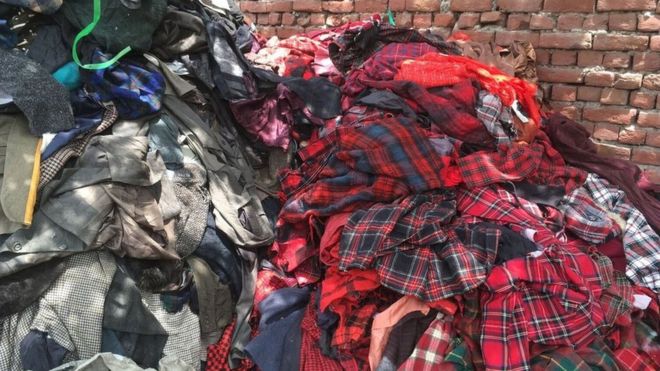Bby SHILPA KANNAN
 Torn or damaged clothes from the UK, US and other countries often end up in Panipat in India
Torn or damaged clothes from the UK, US and other countries often end up in Panipat in India
Ever wonder where your clothes go after you discard them?
In Western countries, when you donate clothing to charities via shops, collection bags, or clothing banks many are given to those in need or sold in charity shops to raise funds.
But what happens to torn or damaged clothes, or items that no one wants to buy?
Often, they are sent to India, joining a global second-hand trade in which billions of old garments are bought and sold around the world every year.
Specifically, to Panipat in northern India which is known as the world’s “cast off capital”.
Every day hundreds of tonnes of clothes from across the UK and the US, and other countries, arrive in Panipat.
Outside the town, you can see long queues of trucks waiting to get in. They come here from the port town of Kandla on India’s western coast – where ships bring containers full of worn clothes and textiles from all across the world.
The businessmen here call them “mutilated” clothing.
India is the top importer of used clothes, beating countries such as Russia and Pakistan, according to the most recent data available.
In India, used clothes can be imported under two different categories – one is mutilated and the other is wearable.
To protect local garment manufacturers in India, importers of wearable clothing need a licence from the government. This licence will only be issued if the buyer guarantees the clothing will not be sold in India, but is instead re-exported.
However, the bulk of Indian imports of used clothing happen in the mutilated clothing segment, which doesn’t require a licence.
In one of the recycling mills, Shankar Woollen Mills, I have to walk over hundreds of colourful buttons on the floor as I try to find my way.
It’s humid and the piles of woollen clothing seem to be adding to the heat on this already hot summer day.
All around me, there are mountains of jackets, skirts, cardigans, berets and what looks like school uniform. From high-street brands to luxury labels – most clothes donated to charity end up here.
Piles of torn and used clothing that would have otherwise ended up as landfill.
Workers are bent over large blades, shredding clothes. They are ripping everything apart to remove zippers, buttons and labels.
BBC for more
